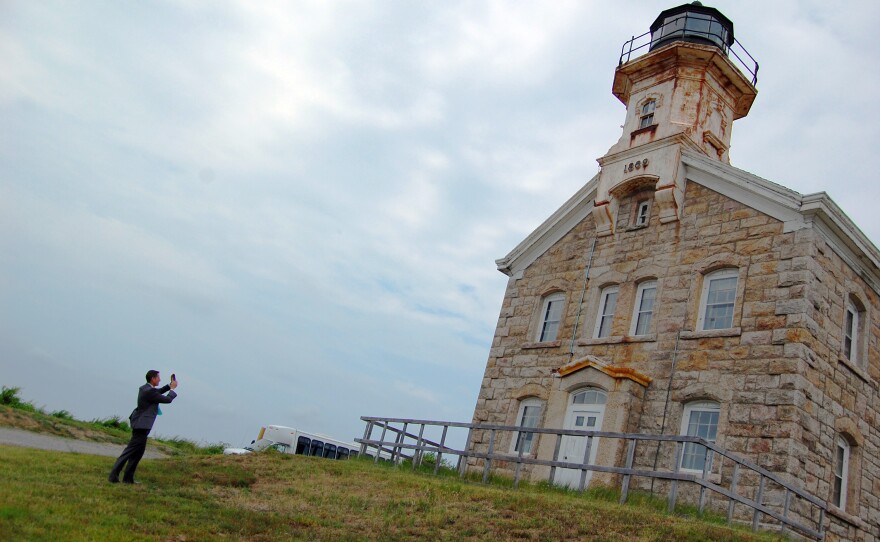From a small grassy hill on the western tip of Plum Island you can look to your right over a small cliff and see Connecticut and Long Island Sound. To the left, the island’s four miles of shoreline rolls out along the Atlantic ocean. Below is Plum Gut, a narrow strait where these two ecosystems collide and churn in a slow circle.
That Plum Island sits at an intersection of multiple ecosystems makes it unique. About three quarters of Plum Island has never been developed. Environmentalists are eager to keep it that way.
“This first time I made it out to Plum, I was really taken aback,” said Leah Schmaltz, the program director for Save the Sound, a coalition of environmental groups dedicated to protecting Long Island Sound. "These acres upon acres of wetlands, and the integrated tapestry of different kinds of habitats that were out there. It was pretty spectacular I have to say.”
The federal government is currently in the process of selling Plum Island. The 840-acre island is about a mile off Long Island’s North Fork, and is home to the Department of Homeland Security’s animal disease lab. The lab is set to move to Kansas sometime around 2020.
Environmentalists say Plum Island is also home to a number of endangered animals that could be harmed by whoever buys the island from the federal government, such as the piping plover and roseate terns.
Schmaltz is threatening to sue the government over the sale of Plum Island. She said that when the government finalized the island for sale, it didn’t consult with the Fish and Wildlife Service, which, Schmaltz said, would have forced the government to sell the island with stipulations protecting endangered species.
“The federal government sidestepped a critical environmental review process and is hoping to move forward with the sale of a de facto wildlife refuge,” she said.
The federal agency selling the island, the General Service Administration, said it is aware of the threat of a lawsuit, but said the agency is only following legislation passed by Congress.
The GSA said preservationists are welcome to bid on the island, but that would pit them against developers who could make a lot of money building posh homes so close to the Hamptons.
“People are willing to pay to be in a certain area,” said David Panetta, the executive director of the Long Island office of Cushman and Wakefield, a commercial real estate firm. “Depending where you are on the east end, it could go $15 million dollars for one acre.”
Panetta said that because taxpayers own Plum Island, the future use of the island should contribute to the economy.
“So produce real estate taxes, produce jobs, and produce a public benefit,” he said.
Panetta advocates for a compromise between environmentalists and those who want full development of Plum Island: allow a corporation to develop a quarter of the island while leaving the rest to nature. Panetta said that Google would, hypothetically, be a good choice.
“Google could have Google Island out there. You could have a Google campus with research and development, but allow them to develop housing for their employees," he said. "That I think would have a job multiplier, where for every one Google job, maybe you could squeeze out another four jobs on the mainland who would be supporting that.”
This hypothetical isn’t too far from what the neighbors want.
Plum Island falls within the town of Southold which controls zoning rights. Officials say residents don’t want to change the current character of the North Fork by adding more traffic to State Road 25.
“It might be a state road, but it’s a little, two lane country road,” said Scott Russell, Supervisor of Southold. “Just getting the vehicles back and forth to the island seems a bit insurmountable to us.”
To keep that character, Southold zoned Plum Island so only research or education could be done in the already developed parts. The rest residents want that preserved so that it doesn’t put more demand on town services, Russell said.
“Southold has never found development to be beneficial to the tax base," he said. "Preservation has always been why we have been able to keep the tax rate lower. More preserve land, less demand on services.”
Russell called the town's commitment against developing Plum Island "iron clad." Developers say Southold just hasn’t been presented with the right proposal yet.
The congressional delegations from Long Island and Connecticut are currently pressing for legislation that would force the federal government to protect Plum Island's environment, including its endangered species.
If Congress doesn't act by the end of the year, environmentalists said they will file a lawsuit to stop the sale.



